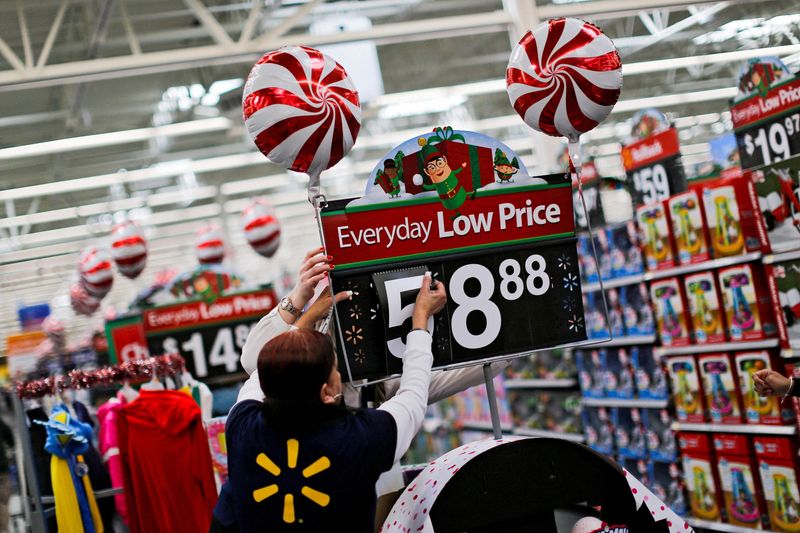By Richa Naidu and Siddharth Cavale
LONDON/NEW YORK (Reuters) - Walmart (NYSE:WMT) is importing more goods to the United States from India and reducing its reliance upon China as it looks to cut costs and diversify its supply chain, data seen by Reuters shows.
The world's largest retailer shipped one quarter of its U.S. imports from India between January and August this year, according to bill of lading figures shared with Reuters by data firm Import Yeti. That compared with just 2% in 2018.
The data shows that only 60% of its shipments came from China during the same period, down from 80% in 2018. To be sure, China is still Walmart's biggest country for importing goods.
The shift illustrates how the rising cost of importing from China and escalating political tensions between Washington and Beijing are encouraging large U.S. companies to import more from countries including India, Thailand and Vietnam.
In the U.S., shoppers face higher interest rates and high food prices, eroding household savings and prompting Walmart and other retailers to become cautious in their outlook for consumer spending.
"We want the best prices," Andrea Albright, Walmart's executive vice president of sourcing said in an interview. "That means I need resiliency in our supply chains. I can't be reliant on any one supplier or geography for my product because we're constantly managing things from hurricanes and earthquakes to shortages in raw materials."
In a statement, Walmart said the bill of lading data painted a partial picture of what it sourced and that creating redundancy "does not necessarily mean" it was reducing reliance on any of its sourcing markets. "We're a growth business and are working to source more manufacturing capacity," Walmart said.
India has emerged as a key component of Walmart's efforts to build that manufacturing capacity, Albright said.
Walmart has been accelerating growth in India since 2018, when it bought a 77% stake in Indian e-commerce firm Flipkart. Two years later, it committed to import $10 billion of goods from India each year by 2027. That is a target it remains on track to hit, Albright said. It is currently importing around $3 billion worth of goods from India each year.
WORKFORCE, TECHNOLOGY ARE KEY DRAWS
Walmart is importing goods ranging from toys and electronics to bicycles and pharmaceuticals from India to the U.S., Albright said. Packaged food, dry grains and pasta are also popular imports from India, she added.
India, whose stock market has risen to record highs this year, is viewed as the country best equipped to outperform China in low-cost, large-scale manufacturing.
Its rapidly growing workforce and technological advancement were a draw for Walmart, Albright said. China on the other hand reported its first decline in population in six decades last year.
Walmart started its sourcing operations in Bangalore in 2002. Now, the company employs more than 100,000 people, including temporary workers, in the country spread across several offices under its Walmart Global Tech India unit, Flipkart Group, PhonePe and sourcing operations.
Walmart CEO Doug McMillon met Indian Prime Minister Narendra Modi in May this year, a meeting that Modi termed "a fruitful one."
"Happy to see India emerge as an attractive destination for investment," Modi wrote on X, formerly known as Twitter, on May 14. McMillon said Walmart would "continue to support the country's manufacturing growth and create opportunity."
Walmart rival Amazon (NASDAQ:AMZN) said this month it is targeting merchandise exports worth $20 billion from India by 2025.
Freewill Sports, a small Indian supplier of soccer balls, is one company that has benefited, its Chief Executive Rajesh Kharabanda said in an interview.
The rising cost of shipping goods from China has also contributed to the switch to India, supply chain experts say.
"Sourcing from mainland China has become less competitive because of rising labor costs versus other manufacturing centers," said Chris Rogers (NYSE:ROG), research analyst at S&P Global Market Intelligence's supply chain analysis group Panjiva.
China's minimum wage changes from province to province and sometimes even from city to city, with a range between 1,420 yuan per month and 2,690 yuan per month ($198.52 - $376.08). Meanwhile, average wages for unskilled and semi-skilled workers in India range from about 9,000 Indian rupees to 15,000 Indian rupees a month ($108.04 - $180.06), according to central bank estimates.
SUPPLY CHAIN SNAGS
The COVID-19 pandemic exposed weaknesses in global supply chains, showing U.S. importers to be over-reliant on a small number of markets.
"Planning for a geopolitical event is like planning for a hurricane," said Albright. "What I can control is where my product is coming from and how do I make sure that Christmas still happens if something happens in our supply chain."
Pakistan and Bangladesh have also benefited from Walmart's strategy, expanding as suppliers of home and apparel products, Albright said.
Last year, at least eight Freewill shipments sailed to Walmart warehouses from Mundra Port in Gujarat, the largest private port in India, according to U.S. import data.
"There is a newfound confidence in the Indian manufacturing industry and also the availability of factory infrastructure," Freewill's Chief Executive Rajesh Kharabanda said in an interview.
India's central bank forecasts that the country's economy will expand 6.5% this fiscal year. China is expected to grow around 5% this year.
"In the last 12 to 18 months there has certainly been a bigger impact," said Shekhar Gupta, whose family business Devgiri has been selling floor rugs to Walmart for about a decade. "That's when Walmart started putting a true strategy behind how they wanted India at the center of their growth."

($1 = 7.1528 Chinese yuan renminbi)
($1 = 83.3050 Indian rupees)